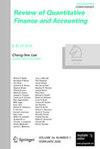股市追逐噪音:对投资者情绪和资产定价动态的调查
IF 1.9
Q2 BUSINESS, FINANCE
引用次数: 0
摘要
摘要本研究探讨了情绪指标在资产定价中的风险因素。使用1993年1月至2020年12月期间的英国市场数据,我们创建了一个新的情绪变量,并通过对各种文献认可的情绪代理的主成分分析构建了原始和清洁的情绪指数。从本质上讲,模型估计分为两个方面:第一,研究记录了传统定价模型对不同特征组成的投资组合的表现。其次,该研究通过将情感变量迭代到模型规范中来增强第一类。研究结果表明,情绪增强资产定价模型在解释投资组合的超额收益方面优于传统模型。此外,使用Hansen &Jagannathan(1997)的非参数模型性能技术,我们观察到情绪诱导的模型与传统模型相比产生了很小的距离误差,从而验证了情绪度量在我们的定价机制中的使用。因此,认为现有的资产定价模型可能不足以解释市场或定价异常。投资者情绪是具有有用信息的重要系统风险因素,市场分析师和利益相关者在预测风险调整收益时必须认真认识投资者情绪的倾向性。本文章由计算机程序翻译,如有差异,请以英文原文为准。
Chasing noise in the stock market: an inquiry into the dynamics of investor sentiment and asset pricing
Abstract This study explores the inclusion of sentiment measures as a risk factor in asset pricing. Using UK market data for the period January 1993 to December 2020, we create a new sentiment variable, and construct both raw and clean sentiment indices from a principal component analysis of a variety of literature-acknowledged sentiment proxies. Essentially, the model estimations are categorized into two: first, the study documents the performance of the traditional pricing models on portfolios formed on different characteristics. Second, the study augments the first category by iterating sentiment variables into the model specification. The findings reveal that sentiment-augmented asset pricing models outperform the traditional models in explaining the excess returns of the portfolios. Furthermore, using Hansen & Jagannathan (1997) non-parametric model performance technique, we observe that the sentiment-induced models produce a small distance error compared to the traditional models, thus validating the use of sentiment measures in our pricing mechanism. It is therefore opined that extant asset pricing models may not be sufficient to explain market or pricing anomalies. Investors’ sentiment is an important systematic risk factor that possesses useful information, and by implication, market analysts and stakeholders must take serious cognizance of its propensities when forecasting risk-adjusted returns.
求助全文
通过发布文献求助,成功后即可免费获取论文全文。
去求助
来源期刊

Review of Quantitative Finance and Accounting
BUSINESS, FINANCE-
CiteScore
3.20
自引率
17.60%
发文量
87
期刊介绍:
Review of Quantitative Finance and Accounting deals with research involving the interaction of finance with accounting, economics, and quantitative methods, focused on finance and accounting. The papers published present useful theoretical and methodological results with the support of interesting empirical applications. Purely theoretical and methodological research with the potential for important applications is also published. Besides the traditional high-quality theoretical and empirical research in finance, the journal also publishes papers dealing with interdisciplinary topics.
 求助内容:
求助内容: 应助结果提醒方式:
应助结果提醒方式:


